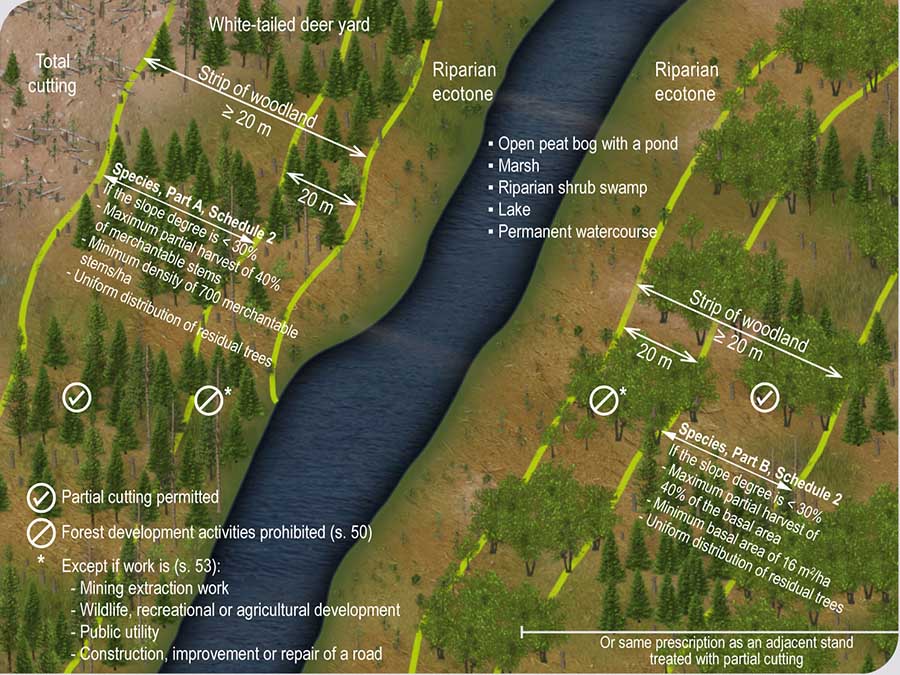Chapter IV – Wildife habitat protection
Division II – Strips of woodland
§1. White-tailed deer yards
Section 50
Despite the provisions of sections 28 and 30 to 32, no forest development activity is allowed within the first 20 metres of the strip of woodland kept alongside an open peat bog with a pond, a marsh, a riparian shrub swamp, a lake or a permanent watercourse located in a white-tailed deer yard.![]()
1
Objective
- To preserve an appropriate riparian environment for use by wildlife
Explanations
Sections 28 and 30 to 32 allow a person to carry out certain forest development activities (e.g. partial cutting and construction of a structure to cross a watercourse) in the strip of woodland alongside a wetland or aquatic environment. However, in a white-tailed deer yard, all forest development activities are prohibited in the first 20 metres of the strip of woodland alongside an open peat bog with a pond, a marsh, a riparian shrub swamp, a lake or a permanent watercourse.
Additional information
It is important to note that the definition of the term “forest development activity” in section 2 of the Regulation means that the standards set out in sections 3, 5, 19 to 22, 47, 50, 52, 54, 55, 57 and 59 do not apply to the repair, maintenance or closure of forest roads or to the control of fires, insect epidemics and cryptogamic diseases.
It should also be noted that section 53 of this Regulation allows certain forestry permit holders to carry out forest development activities in a white-tailed deer yard in the first 20 metres of the strip of woodland alongside an open peat bog with a pond, a marsh, a riparian shrub swamp, a lake or a permanent watercourse. Section 53 also allows for the construction, improvement or repair of a road. Section 53 clarifies the conditions of authorization.
The term “white-tailed deer yard” refers to an area where white-tailed deer gather in winter. The terms “concentration area” and “wintering area” (“ravage” in French) are also commonly used to refer to a white-tailed deer yard. If the white-tailed deer population is to be maintained in Québec, access to good quality wintering areas is essential. The Guide d’aménagement des ravages de cerf de Virginie  (available in French) was prepared to help forest managers improve the quality of white-tailed deer winter habitats when drawing up development plans in deer yards. Among other things, the Guide sets out development principles for deer yards to help ensure that travel corridors and canopy components offering shelter and food are maintained when forestry activities are carried out.
(available in French) was prepared to help forest managers improve the quality of white-tailed deer winter habitats when drawing up development plans in deer yards. Among other things, the Guide sets out development principles for deer yards to help ensure that travel corridors and canopy components offering shelter and food are maintained when forestry activities are carried out.
Figure 50A Rules governing forest development activities in the strip of woodland alongside a wetland or aquatic environment located in a white-tailed deer yard
Figure 50B Rules governing forest development activities in the strip of woodland alongside a wetland or aquatic environment located in a white-tailed deer yard


